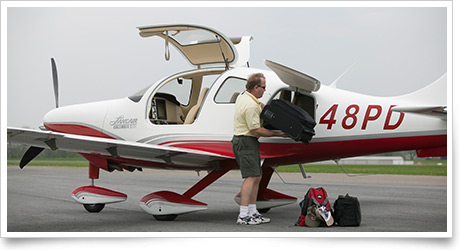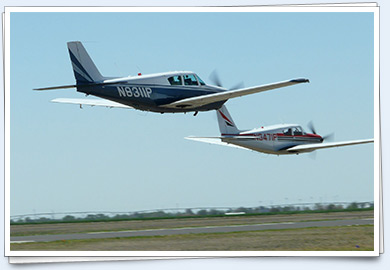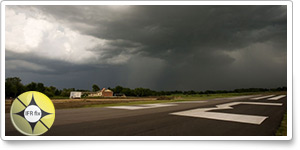| ||||||
| Weight: Worth the worry? |
| |||||
Training TipsWeight: Worth the worry?
What to do now?
Whether it is the number of passengers, the quantity of baggage, or the amount of fuel that must be cut back to bring the flight within limits, don’t give in to any temptation to ignore the problem because of the inconvenience a change of plans would cause. That could be the beginning of trouble—for a long list of reasons.
Even if an overloaded aircraft gets airborne, its climb rate may be inadequate to clear surrounding terrain, especially when density-altitude conditions are eroding performance (see the July 27 “Training Tip: Hedging the heat”).
But that’s just one problem. You’ve heard it said that flying an improperly loaded aircraft makes you an unofficial test pilot. That’s because the aircraft is literally “off the charts” for calculating performance and stability (as determined by the center of gravity position). An aircraft loaded with a CG beyond the aft limits may become more unstable as fuel is consumed and the CG creeps rearward. That could prolong or even prevent a stall recovery.
Then there’s the landing. Aircraft tires, landing gear, and other structural components are made to take a lot of abuse, but there are limits to their ability to compensate for a pilot’s errors. Aircraft weight is often cited as a probable accident cause—even when an aircraft is merely heavy and not overloaded. That’s especially so if other performance-robbing factors were present when the decision was made to launch.
An overloaded aircraft “may exhibit unexpected and unusually poor flight characteristics,” cautions Chapter 9 of the Pilot’s Handbook of Aeronautical Knowledge.
Excess weight, the chapter says, reduces aircraft performance “in almost every aspect.”
As examples, the chapter offers this list: “Higher takeoff speed, longer takeoff run, reduced rate and angle of climb, lower maximum altitude, shorter range, reduced cruising speed, reduced maneuverability, higher stalling speed, higher approach and landing speed, longer landing roll, and excessive weight on the nose wheel or tail wheel.”
Is that the description of an aircraft that a safety-conscious pilot would fly? Flight Training NewsAOPA scholarship recipient now a private pilotJeff Stephenson of Florissant, Mo., became a private pilot on July 14. Stephenson was one of four student pilots who received $5,000 training scholarships at AOPA Aviation Summit 2011. A school teacher and Young Eagles volunteer, he had been anxious to transition from ground-only crew to part of the flight crew so that he can introduce youngsters to aviation. “I would not have completed this ticket without the AOPA’s support,” Stephenson said. He had originally planned to become a sport pilot to save money, but the scholarship enabled him to complete the requirements for the private pilot certificate. Flight Design adds schools to training networkFlight Design USA, the U.S. distributor of CT light sport aircraft, has added three flight schools to its network of training centers. They are North Coast Air in Santa Rosa, Calif.; Southwestern Aviation in Benson, Ariz.; and Hampton Airfield, North Hampton, N.H. “A focus on flight schools is important if we are to grow aviation,” said Flight Design President Tom Peghiny. “Since LSA is an excellent entry point, we feel the establishment of more Flight Design Pilot Centers is a priority.” Flight Design now has 31 U.S. representatives, encompassing flight schools, aircraft sales, and maintenance facilities. Read more >> What's your sign?Stop, do not enter, no right turn. You recognize these signs when you see them on the side of the road, and you know how to respond to them while driving. But what about their aviation counterparts? Airport signs perform the same function as road signs: They provide a safe and orderly way of navigating the pavement maze that is the airport environment. It’s up to you to know how to interpret and respond to them. Take the Runway Safety online course from the Air Safety Institute and learn what the signs are telling you when you’re behind the yoke. Seaplane Pilots Association awards scholarshipsThe Seaplane Pilots Association awarded three scholarships this year at EAA AirVenture in Oshkosh, Wis. The group hopes to offer at least 12 scholarships per year at events around the nation. Read more >> Mesa Pilot Development opens Phoenix training facilityMesa Pilot Development has a new training facility at Phoenix-Mesa Gateway Airport in Mesa, Ariz. The facility offers initial training as well as advanced ratings and certificates. For the first time, training is available to those who are not enrolled in an affiliated degree-based program, Mesa said. The company is a subsidiary of Mesa Air Group Inc., which includes Mesa Airlines. For more information, see the website. Norway flight school orders SkycatchersPilot Academy of Sandefjord, Norway, ordered three Cessna 162 Skycatchers at EAA AirVenture, Cessna Aircraft said Aug. 1. The flight school said Cessna’s effort to facilitate EASA certification by moving the Skycatcher from light sport aircraft category to primary category played a large role in its decision to buy. Cessna announced at AirVenture that it would remove the Skycatcher from the LSA category to help speed up certification in Europe and the rest of the world. Training ResourcesOperating procedures at your home base become second nature during flight training. And just when you’ve got the routine down your CFI announces the next lesson will be leaving the traffic pattern on a flight to a different airport. It’s an exciting prospect—but it can cause some anxiety. Perhaps you’re worried about communicating with air traffic control or self-announcing on the unicom at a nontowered airport. Whatever the case, quell any concerns about unfamiliar airport protocol with the Air Safety Institute’s Airport Operations Safety Spotlight and improve your knowledge before that big day arrives.
Did you know that student pilots who join AOPA are three times more likely to complete their flight training? Membership includes unlimited access to aviation information by phone (800/USA-AOPA, weekdays from 8:30 a.m. to 6 p.m. Eastern time) or from Flight Training Online or AOPA Online. If you’re not already a member, join today and get the pilot’s edge. Login information is available online. Goodyear zeppelin Career PilotLegacy Continental flight attendants ratify contractOn July 13, United Airlines announced that the approximately 9,000 flight attendants at its Continental subsidiary, represented by the Association of Flight Attendants, ratified a new labor agreement. Flight attendants from the company’s United subsidiary ratified a new four-year contract in February. The airline and AFA will commence negotiations soon for a joint collective bargaining agreement covering flight attendants at United, Continental, and Continental Micronesia. Comment delays flight for pilot drug testA passenger’s comment about partying pilots delayed the departure of a U.S. Airways flight from Des Moines by four hours, according to a Des Moines Register blog published June 30. A spokeswoman for the carrier told the newspaper that the flight—to Charlotte, N.C.—was scheduled to leave at 7 a.m., but was delayed two hours because of rest requirements for the crew, whose inbound flight had arrived late the previous evening. As the delayed flight was boarding, a passenger asked the crew if they had partied too much the night before. Because of the comment, the crew had to take a drug test, and the flight eventually took off—six hours after its scheduled departure time. “Any accusation of this sort is taken very seriously and out of an abundance of caution, the crew was administered a drug test,” the airline said. Plane SpotterBeech 2000: Starship inbound Training ProductsQREF Flight Instructor Notebook (Instrument Pilot)Flight instructors who are training for the instrument instructor rating now have a resource. The QRef Flight Instructor Notebook (Instrument Pilot) includes a 42-lesson instrument rating syllabus, 125 instrument rating/proficiency check and study guide questions with detailed answers, 46 practical test standards topic lesson plans, and a checkride checklist, plus other resources. Order it online for $37.99 from PilotMall.com.
Note: Products listed have not been evaluated by ePilot editors unless otherwise noted. AOPA assumes no responsibility for products or services listed or for claims or actions by manufacturers or vendors. Member BenefitsPilot Protection Services health tip: Family treeOn a day when weather or aircraft issues preclude you from flying, take the time to build a family medical tree. Read more from Dr. Jonathan Sackier. Tornado Husky at undisclosed California locationThe AOPA Tougher Than A Tornado Sweepstakes Husky is tucked away at an undisclosed location in Southern California and will remain there until being awarded to its winner at AOPA Aviation Summit Oct. 11 to 13 at Palm Springs, Calif. The Husky flew to the West Coast at the conclusion of EAA AirVenture in Oshkosh, Wis., with a stop at its birthplace, Aviat Aircraft in Afton, Wyo., for its annual inspection. Read more >> BlogsJumpseatingA perk of airline employment, “jumpseating” means you get to ride in the cockpit with the crew, or in the cabin if a seat’s available. But there are certain protocols to follow when seeking a jumpseat, Chip Wright explains. Also in this week’s Flight Training blog, Technical Editor Jill W. Tallman discusses how the news media tend to look at student pilot solos and reveals the results of the July 2012 Flight Training “Since You Asked” digital poll. Four tips to increase student retentionWant to keep your students motivated and looking forward to their next flight lesson? In the latest Learning Curve blog, aviation speaker Ravi talks about cost versus value and the short-sighted sales pitch that “anyone can learn to fly” versus the personal challenge of “you can do it.” AOPA Career OpportunitiesEver dream of turning your passion for aviation into a career? We’re looking for an aviation technical generalist, Web graphic designer, and e-newsletter and social media editor. To learn more about other AOPA career opportunities, visit AOPA Online. Community
AVIATION EVENTS & WEATHER
| ||||||||||||||||||||||||||||||||||||




 It’s not uncommon for a pilot to total up the weight to be carried on a planned trip and discover that it exceeds the
It’s not uncommon for a pilot to total up the weight to be carried on a planned trip and discover that it exceeds the 





